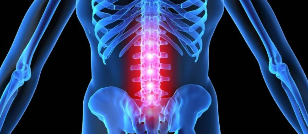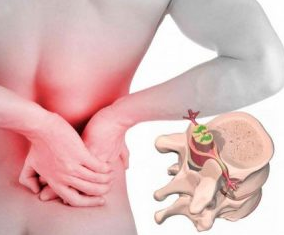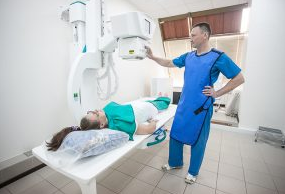Degenerative disease, in which it is destroyed the body of the vertebrae, and takes place the deformation of the intervertebral disc, is called osteochondrosis of the lumbar spine. The causes of this pathology can be diverse, and to properly treat, it is important to determine what exactly has an effect on the course of tension in the lower back. If the person worried about the characteristic symptoms of degenerative disc disease, it is necessary to immediately contact the hospital.
At 1 stage, can cure the problem of medicines and special exercises, but at 2-3 the extent of the conservative method does not always help, and therefore have to resort to surgical methods of treatment.

The main reasons
Left or right lumbar osteochondrosis — a disease of degenerative nature, which is destroyed by the intervertebral disc, torn fibrous ring and the person will appear the hernia, causing a sharp pain and impaired function of the musculoskeletal system. Cause degenerative disc disease in the lumbar can the following factors:
- the increased physical load on the lower spine;
- incorrect position of the body when walking, sitting;
- lack of exercise, sedentary lifestyle;
- broken posture;
- injuries, fractures or bruises, that cause degenerative effects in the spine;
- congenital pathology of the structures of the musculoskeletal system, in which signs of deformation can be observed in the child;
- obesity;
- stress, unhealthy diet.
Stages and symptoms
Symptoms of lumbar degenerative disc disease are evolving with the progression of the disease, and the greater the degree, the stronger the manifested symptom. In total, there are 4 stages:
- At 1 stage, the fibrous ring gets damaged unimportant, the pain is not significant and often troubled, after a long walk. Soreness manifests itself in 2 types — lumbalgie, when it is a symptom of harassing constantly, and lumbago, in which the symptoms occur suddenly.
- Osteochondrosis of the POP 2 the degree is characterized by a large destruction of the fibrous rings and the dmd disk. Such a violation leads to a reduction of the space between the vertebrae and the pressure of the nerve fibers. Continues 2 stage is accompanied by severe pain in the lower back, in the morning he felt the stiffness that a long time does not pass.
- On 3 phase fibrous circle in the affected area completely destroyed, because of what formed the hernia, which compresses the container and the roots of the spinal nerves. My back hurts constantly, the symptoms receded after relaxation and the reduction of the load, he felt the tingling and heaviness in the legs. The third stage occurs degeneration of the muscle fibres, the result is that they are limited to movements of the patient.
- The 4 stages of the spine is completely deformed, a man tormented by acute pain, due to which motor activity is quite limited. Due to the violation of the innervation and blood supply appear swelling in feet, between the vertebrae to grow bone formation. On the last level there is a high risk of disability.
Syndromes are degenerative disc disease of the lumbar spine
Lumbar osteochondrosis manifested by the following syndromes:
- Pain. It is the main symptom, which characterises the degenerative-degenerative disorders in the spine. With the progression of disease symptoms become more pronounced, seizures may last for several days, negatively affect human health.
- Root. Due to the thinning of the damaged body, the disc height of the intervertebral space is reduced, resulting in a vertebra becoming unstable, provoking and squeezing the nerve endings. A man tormented by acute pain syndrome, inflammation of the nerves, circulatory disorders. Muscle skeleton atrophies, what the functionality of the lower limbs is violated.
- Ischemic. Progressive degenerative disc disease of the lumbar leads to the fact that the blood vessels and arteries, piercing the spine begin to compress. This violates the blood supply and nutrition of internal organs and tissues and also becomes the cause of acute pain on the inner side of the thighs, in the crotch area. If the problem can't remove in a timely manner, it is possible paralysis or stump.
- The vertebral. When the progression of pain, coronary and radicular syndromes of the spine of the patient gradually deformed, which significantly affects the condition and feelings. The muscles become weak, changing to walking, the person is trying to distribute the load on the spine so that when you move to have a minimum of discomfort. Such violations affect the work of the internal organs, while the intervertebral discs continue to be even more deformed and damaged.

If treatment is degenerative disc disease of the lumbar was insufficient or performed too late, can develop dangerous complications. For women, damage to the vertebrae at the level of L1—S1, complications can arise during pregnancy, especially in the last dates, when is the load on the spine maximum. In men degenerative processes in the lumbar region often become the cause of problems with potency. Late treatment threatens reactive spondylosis, and also is a high probability that the development of joint arthrosis of the knee, the hip joint. Showing other implications:
- compression-vascular ischemia;
- protrusion;
- spondiloartrozom;
- stump.
Diagnosis
So the doctor was able to choose effective methods of treatment, it is necessary to establish an accurate diagnosis. Diagnosis begins in the office of a neurologist, which holds the primary examination, palpate the affected area, evaluate the course of changes in the spine. In the acute period of the patient with difficulties can move and perform some complex manipulations. For a more detailed study of the vertebral pillar is named instrumental diagnostics, which includes:
- Chest x-rays. Currently underway in the 3 planes, the images show the degree of progression of the pathology, the size of the intervertebral slit, the salt sediments, the structure of the vertebrae.
- A CT scan or MRI. Provide a more detailed picture of the condition of the spine and the discs, show abnormalities in the soft tissues, what cannot be considered when x-ray study.
How to treat the problem?
Medicines
The disease is characterized by the course of the pain symptom with which to cope may not all drugs. In the early stages for the relief of signs can take pain medication pills. And the problem is treated using special ointments and gels. In advanced cases, such as products prove to be ineffective, so the doctor prescribes an injection, thanks to which analgesia and first aid will be timely.

Non-steroidal anti-inflammatory drugs help reduce swelling and inflammation, allowing the nerve fibers and blood vessels cease to compress, and the pain symptoms of thinning. The group includes the means of:
- Drugs against pain. When the progression of the acute period, when the pains are strongly expressed, prescribed drugs of this group. So as they have side effects, is it worth it to buy funds at its discretion. Safe and effective drug should be prescribed by a doctor.
- Muscle relaxants. Eliminate muscle spasms, thereby reducing pain and discomfort.
- Corticosteroids. Eliminate the inflammation, positive effect on the nervous system, improve the condition of the patient in a short time.
Exercise
If it is diagnosed osteochondrosis of the L5—S1 either wonder discs at the level of L3—S1, without exception, is assigned to physiotherapy. In the performance training complex is important to increase the load gradually to avoid discomfort and pain. It is recommended that in osteochondrosis of the following exercises:
- Standing up to do the turns right, left, tilts back and forth.
- Standing on all fours, bend and split back.
- Lying on the floor, lift the straight legs, without lifting the lower back from the floor.
- In the lying position of the left hand to reach for the limb, which is located on the right side and vice versa.
Massage and physiotherapy
Chronic degenerative disc disease in remission successfully treated with the help of massage, carried out by a manual therapist. Massage will help to normalize the blood circulation in the affected section, to put food. A similar effect have physiotherapy treatments:
- electrophoresis;
- magneto-therapy;
- laser;
- UHF.
If sick with the left or right osteochondrosis of the conservative methods do not help, it means that no surgical treatment can not do. It is often applied microdiscectomy, in which are removed sequestered hernia repair using microsurgical instruments. Procedure minime psidium, the second day after the operation the patient can start to move.
Prevention
So as osteochondrosis suffer from both adults and children, it is important from an early age to follow the spine, watch your posture, pay attention to how she looks bending while sitting or moving. If you have a suspicion on the deformation, it is worth it to contact the doctor. The sooner will be diagnosed with the disease, the easier it will be with him then fight.
















